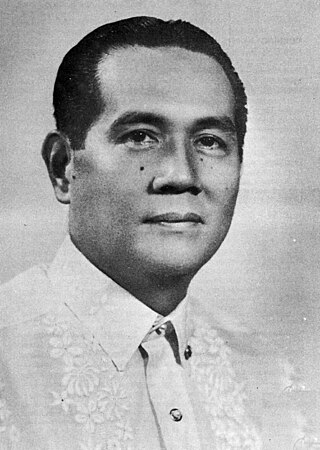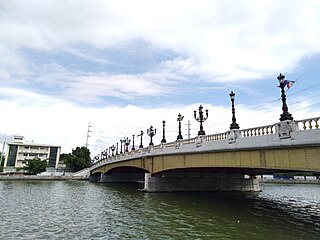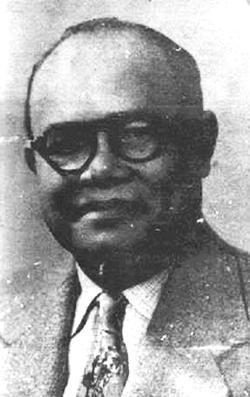 Puerto Real, the former site of the aquarium | |
| Date opened | 1913 |
|---|---|
| Location | Puerto Real, Intramuros, Manila, Philippines |
The Manila Aquarium was a public aquarium in Intramuros, Manila, Philippines.
 Puerto Real, the former site of the aquarium | |
| Date opened | 1913 |
|---|---|
| Location | Puerto Real, Intramuros, Manila, Philippines |
The Manila Aquarium was a public aquarium in Intramuros, Manila, Philippines.
The structure which housed the Manila Aquarium was made by Miguel Antonio Gomez, an engineer, as part of the walled fortification in Manila, Intramuros. [1] It was completed in 1771. In 1913 during the American colonial period. [2] The structure was sustained significant damage in February 1945 during the Battle of Manila of World War II. [1]
President Diosdado Macapagal in the early 1960s pledged for the restoration of Intramuros' walls including the reconstruction of the Manila Aquarium. [3]
The Manila Aquarium was re-established by the Zonta Club in 1968. [1] The aquarium was closed in the 1980s. [4] It opened again briefly as the Acuario de Manila. [5] [ better source needed ]
During the American era, the Manila Aquarium was run by the Bureau of Science. It was housed inside a one-storey structure made of reinforced concrete and had a 85 m × 8 m (279 ft × 26 ft) tunnel. In 1916, there were 27 exhibition tanks installed within the corridor. The aquarium also had two large tanks outside the tunnel which can house crocodiles, sharks, and turtles. Among the aquatic wildlife featured in the Manila Aquarium during this period include sea anemones, crabs, sea urchins, and fishes. [6]

Manila, officially City of Manila, is the capital of the Philippines and its second-most populous city. Manila is located on the eastern shore of Manila Bay on the island of Luzon. It is highly urbanized and as of 2019, was the world's most densely populated city proper. Manila is considered to be a global city and is rated as an Alpha – City by Globalization and World Cities Research Network (GaWC). It was the first chartered city in the country, and was designated as such by the Philippine Commission Act 183 of July 31, 1901. It became autonomous with the passage of Republic Act No. 409, "The Revised Charter of the City of Manila", on June 18, 1949. Manila is considered to be part of the world's original set of global cities because its commercial networks were the first to extend across the Pacific Ocean and connect Asia with the Spanish Americas through the galleon trade; when this was accomplished, it was the first time an uninterrupted chain of trade routes circling the planet had been established. Manila is among the most-populous and fastest-growing cities in Southeast Asia.

Malacañang Palace, officially known as Malacañan Palace, is the official residence and principal workplace of the president of the Philippines. It is located in the Manila district of San Miguel, and is commonly associated with Mendiola Street. The term Malacañang is often used as a metonym for the president, their advisers, and the Office of the President of the Philippines. The sprawling Malacañang Palace complex includes numerous mansions and office buildings designed and built largely in the bahay na bato and neoclassical styles. Among the presidents of the present Fifth Republic, only Gloria Macapagal Arroyo actually lived in the main palace as both her office and her residence, with all others residing in nearby properties that form part of the larger palace complex. The palace has been seized several times as a result of protests starting with the People Power Revolution of 1986, the 1989 coup attempt, the 2001 Manila riots, and the EDSA III riots.

Diosdado Ignacio Jose Maria "Dato" Macapagal Arroyo is a Filipino politician who served as a member of the House of Representatives from 2007 to 2016. He represented Camarines Sur's 1st district from 2007 to 2010, and the 2nd district from 2010 to 2016. Born into the Macapagal family, his mother, Gloria Macapagal Arroyo, served as the 14th president of the Philippines, while his grandfather and namesake, Diosdado Macapagal, was the 9th president.

Diosdado Pangan Macapagal Sr. was a Filipino lawyer, poet and politician who served as the ninth president of the Philippines, serving from 1961 to 1965, and the sixth vice president, serving from 1957 to 1961. He also served as a member of the House of Representatives, and headed the Constitutional Convention of 1970. He was the father of Gloria Macapagal Arroyo, who followed his path as president of the Philippines from 2001 to 2010.

Intramuros is the 0.67-square-kilometer (0.26 sq mi) historic walled area within the city of Manila, the capital of the Philippines. It is administered by the Intramuros Administration with the help of the city government of Manila.

Castle Clinton is a circular sandstone fort within Battery Park at the southern end of Manhattan in New York City. Built from 1808 to 1811, it was the first American immigration station, predating Ellis Island. More than 7.5 million people arrived in the United States at Fort Clinton between 1855 to 1890. Over its active life, it has also functioned as a beer garden, exhibition hall, theater, and public aquarium. The structure is a New York City designated landmark and a United States national monument, and it is listed on the National Register of Historic Places.

Macapagal Boulevard, also known as President Diosdado Macapagal Boulevard and Macapagal Avenue, is an eight-lane road in Metro Manila, Philippines, running parallel to Roxas Boulevard from the Cultural Center of the Philippines Complex in Pasay to Asia World City in Parañaque. It was named after former Philippine President Diosdado Macapagal. This road has three major bridges, crossing the 'channels', of which the largest is the Libertad Channel, where the Libertad Water Pumping Station is situated. Thanks to intersection reconfiguring around EDSA to relieve traffic, Macapagal Boulevard is now often used to access the SM Mall of Asia to the north and Cavite to the south. It is also the main major road in Metro Manila's reclamation area called Bay City.

The University of the Philippines Manila is a state-funded research university located in Ermita, Manila, Philippines. It is known for being the country's center of excellence in the health sciences, including health professional education, training, and research. It is the oldest of eight constituent universities of the University of the Philippines System, even predating the founding of UP by three years. Originally established on December 1, 1905, as the Philippine Medical School and later called as the UP College of Medicine and Surgery on June 10, 1907. It was renamed as University of the Philippines Manila in 1983.

Clark International Airport, known as Diosdado Macapagal International Airport from 2003 to 2012, is an international airport covering portions of the cities of Angeles and Mabalacat within the Clark Freeport Zone in the province of Pampanga, Philippines. It is located 43.2 nautical miles northwest of Manila. It is accessible through the Subic–Clark–Tarlac Expressway (SCTEX).

This article covers the history of the Philippines from the recognition of independence in 1946 to the end of the presidency of Diosdado Macapagal that covered much of the Third Republic of the Philippines, which ended on January 17, 1973, with the ratification of the 1973 Constitution of the Republic of the Philippines.

The National Historical Commission of the Philippines is a government agency of the Philippines. Its mission is "the promotion of Philippine history and cultural heritage through research, dissemination, conservation, sites management and heraldry works." As such, it "aims to inculcate awareness and appreciation of the noble deeds and ideals of our heroes and other illustrious Filipinos, to instill pride in the Filipino people and to rekindle the Filipino spirit through the lessons of history."

Diosdado "Dado" Madarang Peralta is a Filipino attorney and jurist who served as the chief justice of the Philippines from 2019 to 2021. He previously served as an associate justice of the Supreme Court of the Philippines from January 13, 2009, to October 22, 2019. He is the third Sandiganbayan presiding justice to be appointed to the high tribunal.

The William A. Jones Memorial Bridge, commonly known as the Jones Bridge, is an arched girder bridge that spans the Pasig River in the City of Manila, Philippines. It is named after the United States legislator William Atkinson Jones, who served as the chairman of the U.S. Insular Affairs House Committee which had previously exercised jurisdiction over the Philippines and the principal author of the Jones Law that gave the country legislative autonomy from the United States. Built to replace the historic Puente de España in the 1910s, the bridge connects Quintin Paredes Road at the Binondo district to Padre Burgos Avenue at the Ermita district.
The Philippine Law School (PLS), founded in 1915, is a law school in the Philippines. It formerly served as the college of law of National University.

Historical markers are installed by the National Historical Commission of the Philippines (NHCP) in the Philippines and places abroad that signify important events, persons, structures, and institutions in Philippine national and local histories. The plaques themselves are permanent signs installed by the NHCP in publicly visible locations on buildings, monuments, or in special locations. Local municipalities and cities can also install markers of figures and events of local significance. Though they may have the permission of the NHCP, these markers are barred from using the seal of the Republic of the Philippines.

The Aduana Building, also known as the Intendencia, was a Spanish colonial structure in Manila, Philippines that housed several government offices through the years. It is located in front of the BPI Intramuros at Plaza España, Soriano (Aduana) Ave. corner Muralla St. in Intramuros.

The Ayuntamiento de Manila is a building located at the corner of Andrés Soriano Avenue and Cabildo Street, fronting Plaza de Roma in Intramuros, Manila, Philippines. Also known as the Casas Consistoriales and also nicknamed as the Marble Palace, the Ayuntamiento was the seat of the Manila City Council, which consisted of two alcaldes, eight oidores (judges), a clerk, and a chief constable. Destroyed in World War II and reconstructed thereafter, the building now houses the offices of the Bureau of the Treasury.
1961 in the Philippines details events of note that happened in the Philippines in the year 1961.

Gabriel Fabrero Fabella was a prominent Filipino historian during the 20th century. He is primarily known as the historian behind Philippine President Diosdado Macapagal's decision to issue Proclamation No. 28 on May 12, 1962, which changed the date of Philippine independence from July 4, 1946 to June 12, 1898 — the date when Philippine President Emilio Aguinaldo proclaimed the country's independence from Spain in Kawit, Cavite. For this achievement, Fabella became known as the "Father of June 12 Independence Day."
Priority for the second and third year tourist resort development program shall be given to the reconstruction and restoration of the gates and bastions of Intramuros;... the recontruction of the Manila aquarium...